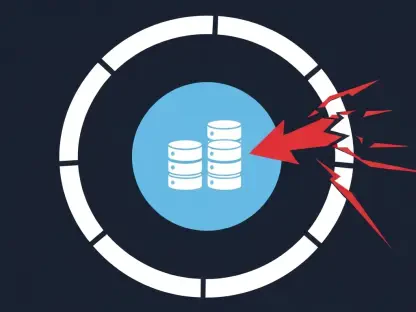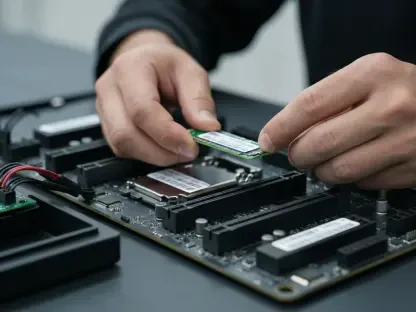In the current year, the cybersecurity landscape has reached unprecedented complexity, compelling businesses to reassess their IT infrastructures urgently. The surge in sophisticated cyber-attacks, particularly zero-day exploits, alongside outdated legacy systems has created a critical need for immediate and comprehensive modernization. These vulnerabilities threaten not only financial stability but also the very credibility of organizations, underscoring the dire need for upgrading IT systems.
Rise of Zero-Day Exploits
Zero-day exploits, which exploit previously unknown vulnerabilities in software, have seen a dramatic increase in recent times, shifting the ratio from 62:38 to 70:30 in favor of zero-day vulnerabilities. This alarming rise calls for immediate attention, as these attacks strike without warning, exploiting unseen security flaws and leaving IT security teams with zero preparation time to mitigate the threat. The unpredictable nature of these exploits means that they can cause significant damage before any patches or protections are put in place.
Unlike n-day vulnerabilities—which are typically patched soon after they are disclosed—zero-day exploits pose a significantly higher risk due to their unpredictability and their potential for immediate, extensive damage. It is this immediacy and the potential for widespread impact that makes them particularly dangerous, especially for businesses that rely heavily on IT infrastructure for their critical operations. Hence, businesses must be vigilant and proactive in addressing these threats by implementing more advanced security measures and continuously monitoring their systems for vulnerabilities.
High-Profile Cyber Incidents
Recent high-profile cyber incidents have made it clear that even major technology providers like Microsoft, Apple, and Ivanti are not immune to sophisticated cyber-attacks. These attacks have exposed critical vulnerabilities in slightly outdated systems, highlighting the potential for catastrophic breaches even in the most secure environments. The reality of the situation is stark: no system, regardless of its perceived security, is entirely invulnerable to modern cyber threats.
In January 2025, for instance, Microsoft unveiled a staggering 159 vulnerabilities, eight of which were active zero-days. This revelation underscored the severity of the current cyber threat landscape and the urgent necessity for implementing robust security measures. The scale and frequency of these vulnerabilities demonstrate that organizations, regardless of their size or reputation, must continually update and reinforce their cybersecurity protocols to stay ahead of potential threats.
Challenges of Legacy Systems
Many organizations continue to rely on legacy systems due to various reasons such as budget constraints, operational dependencies, or the perceived complexities involved in upgrades. However, these systems, while still functional, present significant cybersecurity risks. These outdated infrastructures often lack the necessary defenses to combat modern cyber threats and can easily become entry points for malicious actors.
Mainframe systems, for example, remain crucial for operations in about 70% of Fortune 500 companies and key banks, reflecting a reliance on technology that is increasingly seen as obsolete and vulnerable. The outdated nature of these systems, combined with their central role in critical operations, makes them prime targets for attackers. The intrinsic vulnerabilities in these legacy systems can be exploited to gain unauthorized access, manipulate data, or disrupt services, leading to severe operational and financial consequences for the affected organizations.
Consequences for Organizations
The impact of zero-day attacks can be devastating for organizations, leading to severe data breaches, substantial financial losses, and irreparable reputational damage. The average cost of a breach has risen alarmingly to $4.88 million per incident globally, which highlights the significant financial toll on businesses. These breaches not only involve direct financial losses but also costs related to legal fees, regulatory fines, and efforts to restore the compromised systems. The financial impact is further exacerbated by potential loss of customer trust and market position.
The healthcare sector, in particular, is extremely susceptible to cyber-attacks, with critical patient data often compromised due to vulnerabilities in legacy systems. The potential consequences here are even more dire, as breaches can lead to unauthorized access to sensitive medical records, disruptions in medical services, and a loss of trust among patients. The urgent need for modernization in this sector is clear: upgrading IT systems and enhancing security measures are vital to protect not only financial assets but also the well-being and privacy of individuals.
The Urgency for Modernization
Modernizing IT infrastructure is crucial for effectively mitigating cybersecurity risks. Advanced security tools built on contemporary infrastructure can significantly enhance threat detection and response capabilities, which are essential for combating sophisticated cyber exploits. These modern tools are designed to identify potential threats proactively, monitor system activities in real-time, and respond swiftly to any anomalies, thereby reducing the impact of cyber-attacks.
Furthermore, network segmentation is a vital strategy in the cybersecurity arsenal as it helps in isolating breaches and restricting the lateral movement of attackers within a network. By dividing a network into smaller, more secure segments, organizations can contain potential breaches more effectively, limiting the damage that attackers can inflict. While network segmentation alone is not a standalone solution, it complements other modernization efforts by adding an additional robust layer of defense, making it considerably more difficult for attackers to move laterally within the network.
The Role of AI and Automation
Artificial intelligence (AI) tools have become essential in the cybersecurity landscape due to their ability to process large volumes of data, identify threats preemptively, and enable swift incident responses. The AI cybersecurity market’s projection to reach $134 billion by 2030 emphasizes the growing importance and reliance on these advanced technologies. AI can analyze patterns and behaviors faster and more accurately than traditional methods, flagging potential security incidents before they escalate into full-blown attacks.
However, while AI offers substantial benefits for defense, it also introduces new challenges as cybercriminals increasingly leverage AI for their malicious activities. This dual-edged nature of AI necessitates that businesses stay ahead by adopting advanced AI-enabled security solutions. Organizations must continually update and refine their AI tools to effectively counteract both known and emerging threats, ensuring that they can swiftly adapt to the evolving tactics deployed by cybercriminals.
Evaluating IT Environments
Organizations need to start with thorough evaluations of their current IT infrastructures to identify critical vulnerabilities and develop strategic plans for modernization. These evaluations should aim to pinpoint weaknesses that could be exploited by malicious actors and outline practical steps for addressing these vulnerabilities effectively. This strategic approach ensures that IT environments are not only secure but also resilient against future threats.
Balancing technological advancement with operational stability is key to successful modernization. It’s essential that organizations adopt new technologies in a manner that does not disrupt their ongoing operations or compromise their service delivery. This balance can be achieved by phased implementation, continuous testing, and seamless integration of advanced technologies that strengthen security postures while maintaining business continuity.
Next-Gen Security Solutions
This year, the cybersecurity landscape has gotten more complex than ever, forcing businesses to urgently reassess their IT infrastructures. The dramatic rise in sophisticated cyber-attacks, especially zero-day exploits, coupled with outdated legacy systems, has created an urgent need for comprehensive modernization. These vulnerabilities do not just pose a risk to financial stability but also call into question the credibility of entire organizations. For instance, zero-day exploits are particularly nasty because they target unknown vulnerabilities, catching businesses off guard and unprepared. This kind of attack can wreak havoc before any patches or defenses can be put in place.
Additionally, the aging legacy systems many companies still rely on were not built to fend off today’s advanced threats. Their outdated architecture and technology are ill-equipped for modern cybersecurity challenges, making them prime targets for cybercriminals. The dire necessity to upgrade IT systems, therefore, is not merely a recommendation but an absolute imperative. Companies must adopt new measures and technologies to stay ahead of these ever-evolving cyber threats, ensuring their financial stability and safeguarding their reputations. Taking these steps proactively is the only way to remain secure in this complex, digital age.









